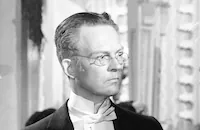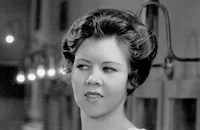Flight for Freedom
Brief Synopsis
Cast & Crew
Lothar Mendes
Rosalind Russell
Fred Macmurray
Herbert Marshall
Eduardo Ciannelli
Walter Kingsford
Film Details
Technical Specs

Synopsis
In 1932 novice pilot Tonie Carter flies her first solo flight and almost collides with Randy Britton, an acclaimed pilot who thinks that women belong on the ground and not in the air. To apologize to Randy for her near miss, Tonie goes to find him at the back room of Johnny Salvini's New York nightclub, where the pilots congregate. The room is restricted to male pilots, and to gain admittance, Tonie lies that she has a date to meet Randy there. Intrigued, Randy invites her to dinner, and after flying her to Delaware to dine on clams, he suggests they spend the week together while the wing on his plane is being repaired. At first reluctant, Tonie agrees to fly to Virginia Beach with Randy and they spend the night together. The next morning, Randy presents Tonie with a cigarette case featuring a map of the world with a gem marking the city of Virginia Beach. Soon after Randy is notified that his wing is fixed, he takes off for a test flight to California and South America. Tonie, who has fallen in love with Randy, watches in tears as his plane disappears into the distance, leaving her alone on the beach. Tonie then goes back to New York to work for her flying teacher, airplane designer Paul Turner. Two years later, Randy returns from South America and asks Paul about Tonie's whereabouts, but Paul claims ignorance. After Randy leaves, Paul tells Tonie of the visit and asks her to fly his prototype in an upcoming New York-Los Angeles race. Because the prize money would provide Paul with the funds that he needs to begin production on the aircraft, Tonie determines to win the race and flies the aircraft to an altitude of 20,000 feet to catch a tail wind. Passing out from lack of oxygen, Tonie regains consciousness as her plane begins to plummet. She manages to level out the craft, but strays from her course and, as a result, finishes last in the race. After Tonie lands in Los Angeles, Randy tries to renew their romance. Although she still carries Randy's cigarette case, Tonie refuses his offer to fly to San Francisco and instead determines to break the world's record by flying to New York that night in less than twelve hours. Tonie takes off without notifying anyone, and as Randy and Paul argue over her, word comes that she has landed in New York and broken the record. Tonie's feat brings her fame and Paul fortune. The night that Johnny mounts a coathook with Tonie's name on it on his clubroom wall, Paul, now a successful plane manufacturer, asks Tonie to marry him and retire from flying. Tonie accepts, but when she sees Randy's name plate next to hers, she tells Paul that she wants to fly around the world solo before they marry. As Tonie begins her journey, Randy follows her progress from Washington, D.C., where he has gone to report sighting a submarine base while flying over the Japanese islands. Because planes are forbidden to fly over the islands, Admiral Graves fears that the Japanese are covertly arming themselves. Tonie's flight gives the admiral an idea on how to send planes over the islands, and he cables her to discontinue her trip and come to Washington to discuss a secret government mission. Tonie receives the admiral's cable when she lands in Honolulu, and after deliberately crashing her plane on the runway, she proceeds to Washington. There, the admiral tells Tonie that the safety of the country depends on her mission and asks her to resume her solo flight and issue a distress call as she nears the Japanese islands. After issuing the distress call, the admiral instructs Tonie to land her craft on the tiny coral reef of Gull Island, where she and her navigator will be picked up by a Navy boat. He explains that Tonie's disappearance will provide Navy surveillance planes with an excuse to fly over the islands, and the Japanese will be unable to protest because of Tonie's fame. After reassuring Paul that she will return, Tonie flies from Miami to New Guinea. At a small hotel there, she meets the navigator assigned to direct her to Gull Island. The man is Randy, who has been ordered to stow away in her plane before takeoff the next morning. On the veranda outside their hotel rooms, Randy proposes to Tonie and tells her that he had planned to propose to her the night she stood him up in Los Angeles. Tonie angrily replies that he is too late, for she is engaged to Paul and would never betray him the way Randy betrayed her. Later that night, Tonie enters the hotel lobby alone, and the desk clerk, Mr. Yokahata, calmly informs her that the Japanese are aware of her mission and plan to rescue her as soon as she lands on Gull Island. Realizing the importance of her assignment, Tonie decides to take off the next morning alone and disappear into the South Seas. Later, as Tonie and Randy stand on their veranda, watching the rain, Tonie confides her love to Randy, and they begin to dream of having a home and family together. When Randy awakens the next morning, however, he discovers that Tonie has gone, leaving behind her cigarette case with an "x" marking Gull Island. Radio reports track Tonie's progress, and soon news comes of her dwindling fuel supply. As she nears Gull Island, Tonie radios in a distress call and then begins to plummet into the sea. Panicking at the last minute, she ascends to an altitude of 20,000 feet, and after she blacks out from lack of oxygen, her plane crashes into the stormy seas. Some time later, Randy leads an American bombing mission on the Japanese islands, and after dropping his load of bombs, he pulls out Tonie's cigarette case and places a check mark on the target.

Director
Lothar Mendes
Cast

Rosalind Russell

Fred Macmurray

Herbert Marshall

Eduardo Ciannelli

Walter Kingsford
Damian O'flynn
Jack Carr
Matt Mchugh

Richard Loo
Charles Lung
Bud Mctaggart
Bruce Edwards

Don Dillaway
Eddie Dew
Jack Cheatham
Frank Mills
Ed Agresti
Paul Stanton
Ann Summers
Stanley Andrews
Gerald Pierce
Tom Dugan
Ernie Alexander
Bud Geary
Buddy Williams
Joe Cunningham
Martin Ashe
James Craven
Byron Shores
Clive Morgan
Pat Gleason
James Seay
Joey Ray
Hugh Beaumont
Frank M. Thomas
James Eagles
Tony Hughes
Chester Huntley
Edward Fielding
Theodore Von Eltz
Charles Flynn
Paul Mcvey
Dick Bartell
Joseph H. Peters

Mary Treen
Norman Ainsley
Shirley Lew
William Forrest
Edwin Stanley
John Vosper
Clarence Straight
John Arthur Stockton
George Sherwood
John Marvin
Forbes Murray
Jack Carrington
John Wald
Isabelle La Mal
Ariel Heath

Mary Halsey
Kathleen Ellis
Crew
Adrian
C. Bakaleinikoff
Carroll Clark
Frank Clark
Albert S. D'agostino
Fred Fleck
Lee Garmes
Oliver H. P. Garrett
Roland Gross
David Hempstead
S. K. Lauren
Lt. J. J. Mccormack Usn
Horace Mccoy
Harley Miller
Jane Murfin
Frank Redman
Ruby Rosenberg
Darrell Silvera
J. D. Starkey
James G. Stewart
John E. Tribby
Vernon L. Walker
Roy Webb

Film Details
Technical Specs

Award Nominations
Best Art Direction
Quotes
Besides, fliers aren't good for women -- ever.- Paul Turner
Oh, I know. Every flier's married to his plane.- Tonie Carter
Not quite that bad. But they never know what's going on inside of other people. How can they? They live 10,000 feet up in a world entirely their own. Any girl's safer to leave them there.- Paul Turner
Dad always used to say, when you're safe... you're dead.- Tonie Carter
Trivia
Notes
The working title of this film was Stand to Die. The picture's opening sequence shows American battle squadrons speeding toward the Japanese islands in 1943. Over the image of the planes, a narrator explains that a spirited American woman risked her life to secure strategic information about secret Japanese combat bases on those islands. Although pre-production news items in Hollywood Reporter place Tom Conway and Harold Huber in the cast, neither appears in the completed film. Other news items in Hollywood Reporter offer the following information about the film's production: In June 1942, RKO moved up the film's production date to exploit the U.S.'s recent victories at Midway Island. In early September 1942, Frank Redman took over the photography from Lee Garmes when Garmes was called back to Twentieth-Century Fox to film China Girl. The overwater aviation shots were filmed in Chicago, Il., because the Atlantic and Pacific coasts were closed to filming due to the war.
Many of the reviews note the strong parallels between the life of aviatrix Amelia Earhart and the character of "Tonie Carter." According to the Hollywood Reporter review, there was much speculation at the time that Earhart's disappearance during her round-the-world flight in July 1937 was staged to allow search parties to fly over the Japanese islands, much like "Tonie's" disappearance in this film. A modern source adds that George Palmer Putnam, Earhart's widower, allowed the film to be made on the condition that his late wife's name not be mentioned. Fred MacMurray was borrowed from Paramount to appear in this film. According to a news item in Hollywood Reporter, the proceeds from the Hollywood premiere were given to war charities. This picture was nominated for an Academy Award for Best Art Direction and Interior Decoration. Rosalind Russell reprised her role in a Lux Radio Theatre broadcast on September 20, 1943, co-starring George Brent. A biographical film about Earhart herself was the 1976 NBC television movie Amelia Earhart, directed by George Schaefer and starring Susan Clark and John Forsythe.












